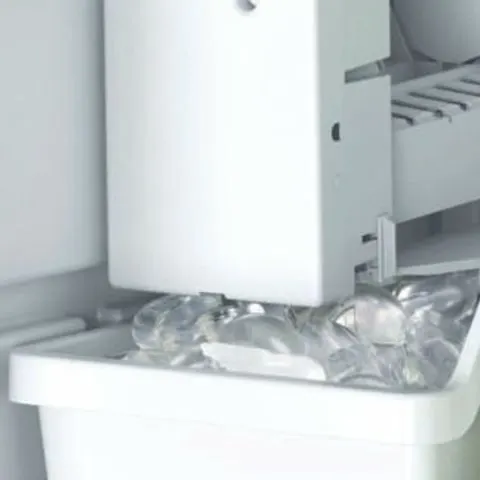Your KitchenAid ice machine creates a bucketful of ice cubes that it holds in its container until someone presses a button to dispense a couple. When you push the dispensing handle, a motor spins an auger that then pushes ice cubes out.
The auger sits at the bottom of the ice bucket and has corkscrew grooves that carry ice cubes out for as long as it is spinning.
Since it is a purely mechanical unit, you will get no ice cubes when the auger is stuck, or the motor is not running.
Make Sure There’s Mains Power, and the Unit is Plugged in
Since the motor spinning the auger is electric, you won’t get any ice flow if there is a power blackout or the ice machine isn’t plugged into a working power source.
Confirm that there is the power to the unit by checking any other parts that use electricity. These include:
- Checking to see if the compressor is running
- Looking for any lights
- Using the control panel if your unit has digital controls
If there is a power blackout or you have reason to believe your entire ice maker isn’t getting power, start by fixing that problem before moving on.
Test Whether the Auger Motor is Working
If there is power to the unit, but the auger isn’t turning, you will have to verify whether the motor is working.
Normally, the motor/gearbox makes enough noise to be heard with the freezer door closed.
To test whether the auger motor is working:
- Open the freezer door and grab the bottom of the ice bin. Carefully lift up on the front of the bin and pull it from the freezer.
- Lift the wire shut-off arm to turn off the ice maker or turn off the power switch on the ice maker.
- Press the Ice button on the dispenser door if your dispenser does not have separate ice and water dispenser levers. Push and hold the door switch that controls the freezer light. This switch also lets the ice maker dispense ice through the door, disengaging the dispenser when the door is open.
- Push on the ice dispensing lever as you watch the auger motor at the back of the freezer. If the motor jumps slightly but doesn’t turn, chances are the motor is frozen from moisture.
- Use a nut driver to remove the screws holding the auger motor to the back of the freezer. Reach behind the motor and pull the wire harness from the freezer’s back wall.
- Place the auger motor on a towel and allow the moisture to melt from inside the unit. Once the auger reaches room temperature and the moisture melts, try to turn the auger motor shaft. If the shaft fails to turn, replace the auger.
Loose or Disconnected Linkage from the Motor to the Auger
The auger motor has to transmit all that kinetic energy it makes to the auger somehow. It could do this through a basic drive shaft or a set of gears.
If the drive shaft is broken or the gears are stuck/missing, the auger motor will hum away, but all that motion can get to your auger.
Luckily, the linkage should be simple and easily comprehended once the bucket is disassembled. Check for visible breakages, misaligned gears, or stuck gears that fail to move when the motor spins.
ProTip: You can spin the motor input side by hand to check if the force transfers to the auger.
Check Whether the Auger Spins Freely
The final thing you could check is whether your auger spins freely. A stuck auger could be more than the motor or gears can handle. Though rare, when the auger sticks, the drive system from the motor will slip, or the motor will downright fail to spin.
You can check if your auger is stuck by:
- Drain the ice from the ice machine until you can access the auger
- Unplug the ice maker from the power
- Hold the auger deftly by hand and try spinning it (in the correct direction)
- I should spin freely if not stuck
If it seems stuck, you will have to clean it thoroughly, removing any residue or caked-on ice that could be holding it in place. You can try breaking it free further by opening up the bucket and disassembling the auger and its drive mechanism before reassembling the individually cleaned parts.

